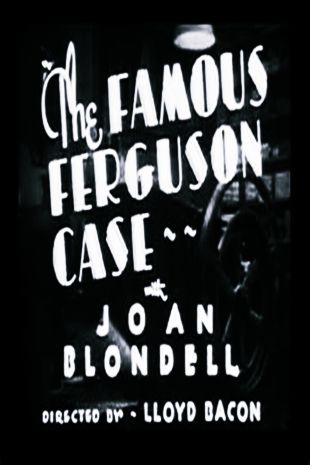The Famous Ferguson Case is a very peculiar movie, no matter how one looks at it. For starters, there's the billing and the structure -- based on the credits, the film's two nominal stars are Joan Blondell and Grant Mitchell (?!), yet neither one shows up on-screen until more than 20 minutes into the picture; and Mitchell's character actually appears a few minutes before Blondell's, who then disappears for another 10 minutes or so. And then there's that cautionary opening, presented with internal newspaper-style editing, warning the audience of the perfidious nature of some members of the press corps (circa 1932). And there's the script, which aims its barbs at both small-town provincialism and big-city cynicism in equal measure -- this little 74 minute drama/mystery wants to be a lot of things, including a message picture along the lines of I Am A Fugitive From A Chain Gang and Cabin In The Cotton, a mystery-thriller, a romantic drama, a social critique, and an old-style country/city conflict story. Principal writers Courtney Terrett and Harvey F. Thew have fired what amounts to a load of thematic buckshot that spreads out in all directions, and with surprising effectiveness -- the central story, of a small, upstate New York town's social fabric and justice system corrupted and destroyed, along with several lives, by unscrupulous big city newspapermen, is never far from the center of the film; but the tale of two would-be lovers parted by that corrupting influence is just as central to the tale. And the period details are fascinating, as the honest but impressionable newspaperwoman played by Adrienne Dore looks longingly at the pages of Vogue, pondering what she would like to do in New York, and is brought to ruin, personal and professional, by the influence of these visitors from that city, while her one-time paramour Bruce Foster (Tom Brown) parts with her in every way possible in the same circumstances. The story weaves those two tales together very successfully if a bit heavy-handedly, with Joan Blondell and Grant Mitchell -- the supposed stars of the film -- providing a kind of Greek chorus to the proceedings. The entire movie plays like a more didactic cousin to Mervyn LeRoy's Five Star Final (made at the same studio a year earlier), with less energy but a bigger array of targets in its sights. It might not be quite as piercing as the earlier film, but it's well worth a look, even eight decades later, and most of what it has to say about journalism is even more relevant in the internet era than it was in 1932.

The Famous Ferguson Case (1932)
Directed by Lloyd Bacon
Genres - Drama |
Release Date - May 14, 1932 (USA - Unknown) |
Run Time - 80 min. |
Countries - United States |
MPAA Rating - NR
Share on